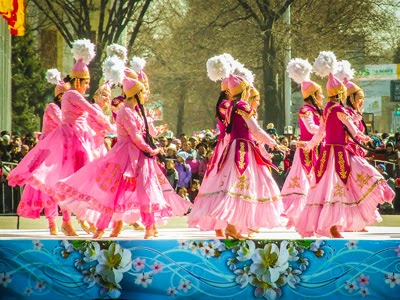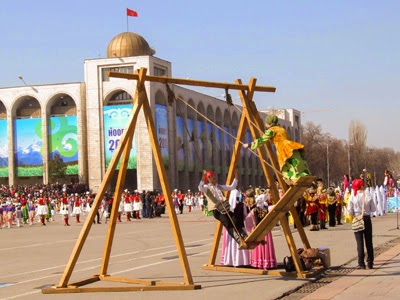 |
| Lilya Kas'yanova |
Part 2, to be published next week, will describe the Nowruz festive table and the culinary subtleties of the Kyrgyz and Kazakh peoples.
Overview of Nowruz
One of the world’s most remarkable festivals – Nowruz (Spring New Year) – was added to UNESCO’s list of Intangible Cultural Heritage in 2009. It is celebrated in Central Asia, Afghanistan, the Middle East and other countries. In some countries, Nowruz is officially listed on the public holiday calendar. And, in the Republic of Kazakhstan, it is fêted for consecutive three days.
 |
| Folk music groups, Nowruz festival Bishkek. image: Lilya Kas'yanova |
"Nowruz' in Farsi means "new day" and 21 March - the spring equinox - is the first day of the New Year of the Persian calendar. It is a festival of spring, nature’s great awakening: renewal and purification, fertility, the demonstration of the love of nature, the triumph of love and the friendship of peoples.
The colourful traditions of the Nowruz celebration took root not only in Persian-speaking regions, but also gained ground among those Turkic-speaking nations influenced by the culture of Zoroastrianism. The spring New Year lived through the Arabian conquest: Islam had never banned the ideas of goodness, mercy and beneficence, and it remained an integral part of the cultures of different Muslim peoples.
When Tsarist Russia annexed Central Asia, this new authority did not interfere with local traditional practices, customs and beliefs. However, after the Great October Socialist Revolution in 1917, the situation regarding traditional rituals, including festivals and feasts, changed dramatically. In the Soviet period, Nowruz lost its status as an official holiday in 1926 for no other reason than the exponents of the party’s ideology decided it had a religious nature.
 |
| Children of the Tatar-Bashkir diaspora at Nowruz, Bishkek image: Lilya Kas'yanova |
Kaleidoscopic Nowruz traditions of Central Asia
The week before Nowruz is considered a time of ancestral remembrance: it is dedicated to them. People bring offerings to the spirits of dead persons and ask for their assistance and protection in the coming year.
A few days prior to Nowruz, active preparations for the upcoming celebration are launched: thoroughly cleaning the house, clearing out old and useless things, making or buying holiday clothing and so on. Before 21 March, debts should be repaid, misfortunes forgotten and offences forgiven.
On the eve of Nowruz, a purification ceremony is performed to frighten away evil spirits. In Kyrgyzstan and Kazakhstan, there is the practice of fumigating homes using juniper twigs. In Tajikistan, the peganum harmel plant (Syrian or wild rue) is used for the same purpose.
Nowruz is the longest holiday in the East: according to tradition, it lasts thirteen days and the last day should be spent outdoors. People enjoy holding parties in the countryside to reunite with nature. Throughout Nowruz, people visit their relatives and friends, exchange greetings, provide alms to the poor, and cook a great variety of specialties.
The festive table has to be overladen with rich food to ensure the coming year will be abundant and fertile and bring joy and luck. The observance of the different rites that accompany the Nowruz celebration, makes for family happiness and well being.
 |
| Folk dance ensemble, Nowruz festival Bishkek, image: Lilya Kas'yanova |
In Zoroastrianism, the festival focused on the main object of worship, i.e. fire, which had the power of purification, and was deemed to be the symbol of the sun on earth.
Historically, one more symbolic purification ceremony, related to fire, fell during Nowruz. At sundown, people jumped over big bonfires: jumping over fire was believed to banish corrupt desires and demonic temptations.
Even women with babes in arms jumped over bonfires: they genuinely believed that it could guard from evil spirits and protect from bad luck. As far as Central Asia is concerned, this rite is still observed in some remote, rural areas.
Among the Kyrgyz, Nowruz was known as "Ulustun uluu künü" ("Great Day of the Nation" or "Great Day of the Khanate"). This day was often marked by an important event, such as the election of a new chieftain.
There is a wonderful custom in Tajikistan known as gülgardoni. With the advent of Nowruz, children pick the first spring flowers – snowdrops and crocuses, and distribute them to neighbours, thus acting as heralds bringing the glad tidings of the incoming spring.
Nowruz celebrations also include entertainment, national sports and equestrian games, such as horse races (at chabysh); buzkashi (also known as ulak tartysh, or kuk pari); oodarysh (wrestling on horseback); tyiin enmei (picking up coins from the ground while galloping); archery and wrestling etc.
 |
| Kyrgyz merry-making. Central Ala-Too Square, Bishkek, image: Lilya Kas'yanova |
The second part of this article will focus on the Nowruz festive table.
Contact Lilya on: lolya.87(at) mail (dot) ru
Read all Lilya's articles
Related posts: Nowruz Spring Festival – #2
Celebrating Nowruz - Spring New Year in Uzbekistan
100 Experiences of Kyrgyzstan